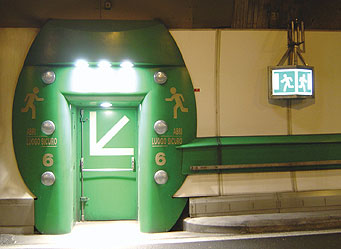U.S. Department of Transportation
Federal Highway Administration
1200 New Jersey Avenue, SE
Washington, DC 20590
202-366-4000
Focus
| Accelerating Infrastructure Innovations |
Publication Number: FHWA-HRT-07-013
Date: May 2007
The goal of bringing back international innovations and best practices in designing, building, and operating tunnel systems took a team of Federal, State, and local highway and transit agency and industry representatives to Europe in fall 2005. The scanning team tour was sponsored by the Federal Highway Administration (FHWA), American Association of State Highway and Transportation Officials (AASHTO), and the National Cooperative Highway Research Program (NCHRP). Team members visited Denmark, France, Norway, Sweden, and Switzerland. The team also met with representatives from Austria, Germany, Italy, and the Netherlands.
 |
| A tunnel emergency escape route in the Mont Blanc tunnel on the French-Italian border. |
The scan focused on tunnel operations, including incident detection and deterrent technology and incident response and recovery planning, as well as tunnel systems and designs that provide fire protection, blast protection, and areas of refuge or evacuation passages for users. The team also looked at specialized technologies and standards used in monitoring or inspecting structural elements and operating equipment to ensure optimal performance and minimize needed maintenance or rehabilitation.
Team members identified numerous practices that vary from those currently used in the United States in some respect, particularly in the safety area. Many of the innovative European tunnel design and emergency management plans observed are the result of extensive research that considers how people react in tunnel emergencies. For example, the countries visited make instructions for drivers, passengers, and tunnel operators as straightforward as possible to reduce required decisionmaking during an incident such as a tunnel fire. The scan team also observed that the signs used in Europe to indicate tunnel emergency escape routes are uniform from country to country, consisting of a white-colored running figure on a green background. All SOS stations in tunnels are identified by the color orange. These stations are emergency vehicle pullout areas that have items such as communications devices and fire fighting equipment. "This widespread uniformity promotes understanding by all people, and helps assure that in the event of an emergency, any confusion related to the location of the emergency exit will be minimized," notes the scan team in its report, Underground Transportation Systems in Europe: Safety, Operations, and Emergency Response. Combining signs with the use of sound, such as the message "Exit Here," further increases understanding.
Refuge areas are also important. Following a 1999 fire in the Mont Blanc tunnel on the French-Italian border in the Alps, the tunnel was redesigned and rebuilt. The 11.6-km long (7.2-mi) tunnel contains 37 refuge rooms to be used in case of emergency. Designed so that smoke cannot enter them in the event of a tunnel fire, the rooms are spaced 300 m (984 ft) apart, with a vehicle pullout area across from each room.
Europe is also using sophisticated software that automatically detects, tracks, and records tunnel incidents. The system then signals tunnel operators to observe the event and take action if necessary. The countries visited are using "one-button" systems to initiate emergency response actions as well. "The 'press one button' solution initiates several critical actions without giving the operator the chance to omit an important step or perform an action out of order," says scan cochair Steve Ernst of FHWA's Office of Bridge Technology. For example, in the Mont Blanc tunnel operations center, operators can initiate several actions by moving a yellow line over the area where a fire incident is indicated on a computer screen. This one-button action reduces the need for the operator to make time-consuming decisions about ventilation control and other operational procedures.
Another safety practice observed by the scan team is that in several European tunnels, light-emitting diode (LED) lights have been installed along the edge of the tunnel at regular intervals of approximately 10 to 20 m (33 to 66 ft). These white or yellow lights clearly identify the edge of the roadway and are also less susceptible to loss of visibility because of road grime or smoke during a tunnel fire. In some tunnels, blue LED lights have also been spaced at 150-m (490-ft) intervals among the edge-delineation lights. Motorists are instructed to keep a safe distance between them and the vehicle in front, using the spacing of the blue lights as a visual cue.
The scan team has recommended that nine initiatives or practices be considered for possible implementation in the United States:
Implementing these recommendations will involve working with such organizations as AASHTO, the Transportation Research Board, National Fire Protection Association, and the American Public Transportation Association on outreach efforts and the development of standards and guidelines.
Implementation efforts underway include a proposal to incorporate a chapter with guidelines on safety, operations, and emergency response in the new FHWA Tunnel Design and Construction Manual, which is under development. Scan team members have also made numerous presentations to AASHTO and industry groups on the scan findings. "Some of the new tunnel projects under development have expressed interest in some of the innovative design elements from the scan," says Ernst. For example, planners and designers for a new tunnel project that will link the MacArthur Causeway with the Port of Miami in Florida are considering many of the safety design features observed by the scan team. FHWA has also used the scan findings to expand the training module for its workshop on Risk Management for Terrorist Threats to Bridges and Tunnels. "Many of the ideas that make tunnels safer for accidental incidents, particularly fire, are also applicable to mitigate terrorist threats," says Ernst.
For more information on the scan, contact Steve Ernst at FHWA, 202-366-4619 (email: steve.ernst@fhwa.dot.gov). The scan team report, Underground Transportation Systems in Europe: Safety, Operations, and Emergency Response (Publication No. FHWA-PL-06-016), is available online at www.international.fhwa.dot.gov/uts/.